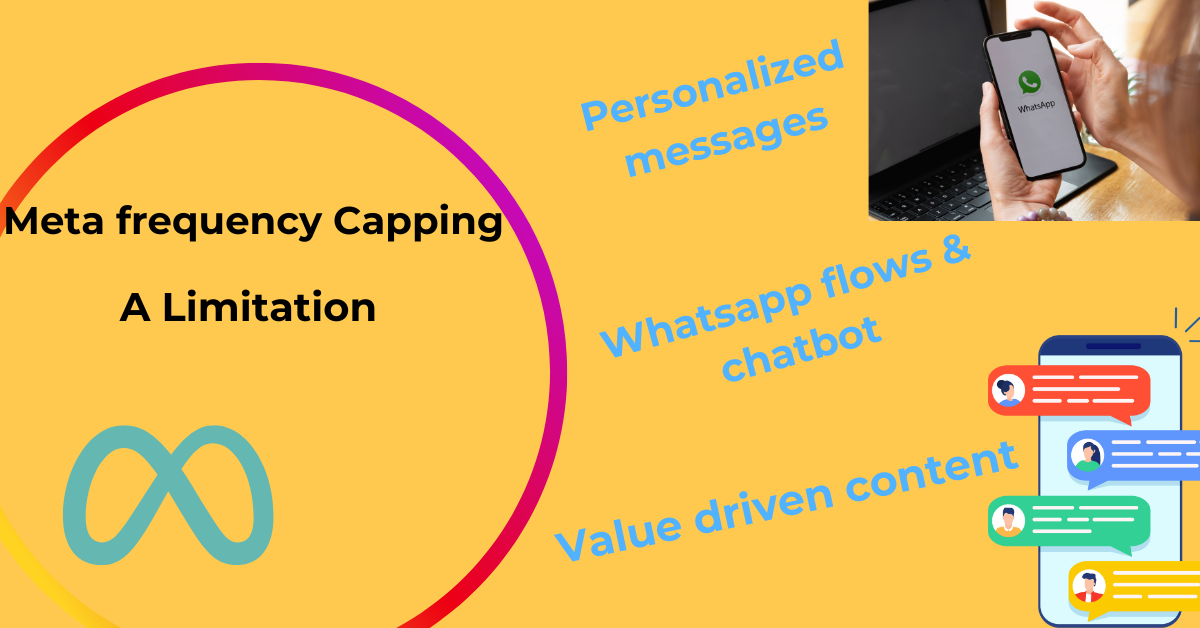Unlearn how to tackle Meta frequency capping with the help of Whatsapp API tools and its features.
In the evolving digital communication landscape, WhatsApp has emerged as a pivotal platform for businesses to connect with their audience. The introduction of Meta’s Frequency Capping has redefined how companies can engage with users, emphasizing quality over quantity. This article delves into the implications of frequency capping, strategies to navigate these limitations, and the role of WhatsApp flows in enhancing user engagement.
Understanding Meta’s Frequency Capping

Meta’s Frequency Capping is designed to enhance user experience by limiting the number of marketing messages a user can receive within a specific timeframe. This measure aims to prevent message fatigue and ensure that users are not overwhelmed by excessive promotional content. The cap is dynamically determined by Meta and may vary, encouraging businesses to adopt more thoughtful and strategic communication approaches.
Implications for Businesses
The implementation of frequency capping necessitates a shift from mass broadcasting to more personalized and meaningful interactions. Businesses must now focus on delivering value-driven content that resonates with their audience. This change encourages the development of stronger customer relationships and fosters a more user-centric approach to marketing.
Strategies to Thrive Within Frequency Capping Limitations
- Personalized Messaging: Tailor your messages to individual user preferences and behaviors. Utilize data analytics to understand customer interests and craft messages that offer personalized solutions or recommendations.
- Quality Over Quantity: Focus on the relevance and value of the content rather than the frequency of messages. Ensure that each interaction provides meaningful information or assistance to the user.
- Opt-In Engagements: Encourage users to opt-in for specific types of communications, allowing them to control the content they receive. This approach increases engagement rates and reduces the likelihood of message fatigue.
- Leverage WhatsApp Flows: Implement interactive conversational flows to guide users through processes such as product inquiries, bookings, or customer support. WhatsApp flows enhance user experience by providing seamless and efficient interactions.
Enhancing Engagement with WhatsApp API Tools
The WhatsApp API tool offers advanced features that enable businesses to implement the strategies mentioned above effectively:
- Automated Responses: Set up automated replies to common queries, ensuring prompt responses and maintaining user engagement.
- Interactive Message Templates: Utilize templates that allow for interactive elements such as quick replies and call-to-action buttons, enhancing user interaction.
- Analytics and Reporting: Monitor message performance and user engagement metrics to refine strategies and improve communication effectiveness.
Implementing WhatsApp Flows
WhatsApp flows are structured conversational paths that guide users through predefined processes. They can be utilized for various purposes, including:
- Whatsapp shopping: Utilize WhatsApp shopping the future of E commerce shopping by browsing the product catalogs and making payments within whatsapp. This can be facilitated by chatbot and whatsapp flows.
- Customer Support: Automate responses to frequently asked questions, providing instant assistance and freeing up human resources for more complex inquiries.
- Product Recommendations: Guide users through a series of questions to offer personalized product suggestions based on their preferences and needs.
- Appointment Scheduling: Allow users to book appointments or reservations through an interactive and user-friendly interface.
Best Practices for Utilizing WhatsApp API Tools and Flows
- User Consent: Ensure that users have opted in to receive messages and are aware of the type of content they will receive. This practice builds trust and complies with data protection regulations.
- Clear and Concise Communication: Keep messages straightforward and to the point, providing users with the information they need without unnecessary complexity.
- Regular Updates and Maintenance: Continuously monitor and update your WhatsApp flows and messaging strategies to adapt to user feedback and changing preferences.
- Compliance with WhatsApp Policies: Adhere to WhatsApp’s business and messaging policies to maintain a positive reputation and avoid potential restrictions.
Conclusion
Meta’s Frequency Capping presents an opportunity for businesses to refine their communication strategies, focusing on personalized and meaningful interactions. By leveraging the capabilities of the WhatsApp API tool and implementing effective WhatsApp flows, businesses can navigate these limitations and continue to thrive in their marketing efforts. Embracing this user-centric approach not only aligns with Meta’s guidelines but also enhances customer satisfaction and engagement.
For a more in-depth understanding and practical applications, consider exploring resources that provide detailed insights into WhatsApp’s messaging policies and best practices.
By adopting these strategies and utilizing the advanced features of the WhatsApp API tool, businesses can effectively engage with their audience, even within the constraints of frequency capping, and foster stronger customer relationships.